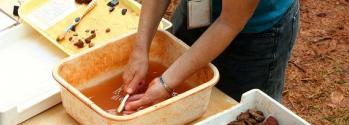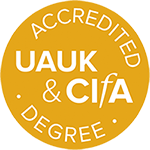
Material Culture
Material culture is fundamental to being human. Things are the medium through which we act, understand ourselves and relate to each other. They habituate our reflexes, make meanings concrete and intervene as agents in our lives. This is as true now as it has been throughout several million years of human evolution. Primates and other animals use tools; we became truly human when the first primate used a tool and then did not put it down afterwards. Because material culture is so omnipresent in human life, studying “material culture” can become a catch-all, encompassing almost anything from philosophical disquisitions on being human to nitty-gritty description of pottery typologies. Our approach is distinctive; its hallmark is a strong central axis bridging ideas and data. Our studies of material culture encompass a broad range of methods, topics and themes, but each study both illuminates a particular body of material and gives general insights about material culture and how to study it:
- How do cutting edge proteomic studies of medieval European manuscripts focus our attention upon the biological nature of the production of high culture?
- How does the patterning in prehistoric Andean objects reveal the heterarchical bonds uniting collectivities?
- How to interpret visual art based on material culture from the earliest objects created and used by Modern Humans and Neanderthals, and where the body becomes the art object itself?
- How to look at the landscape as a set of interwoven connections between its inhabitants, and the way gender and landscape can be interpreted via material culture in Upper Palaeolithic Europe?
- How can we understand portraiture with its social, ritual and ideological implications as a form of material culture, in particular as expressed in Iron Age Europe and Moche Culture (Peru)?
- What does chemical and microscopic study of the terracotta warriors teach about how production in Han China enacted imperial ideology?
- Are human bodies material culture? How do DNA studies help produce human bodies as objectified culture?
- How did Mycenaean burial practice form a dramatic process enacting both solidarity and distinction?
- Was dress in colonial Chile a medium of colonial domination, of local resistance, or both?
- What social tasks did prehistoric “art” fulfil, and how do these reflect longue durée changes in prehistoric Europe’s gender and social worlds?
- How to look at material culture as a medium of story-telling, where the image becomes a three-dimensional representation of social relations, identities and praxis, through the examples of the rock art of Northern Europe and Upper Palaeolithic Franco-Cantabrian cave art?
This distinctive approach is supported within Cambridge Archaeology by (on the one hand) the theoretical discussion of the Material Culture Research Hub, and (on the other hand) by the scientific methods and facilities of the Pitt-Rivers Laboratory for Archaeological Sciences.




